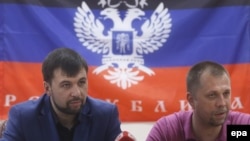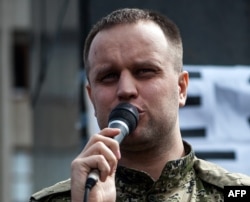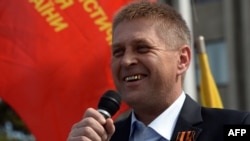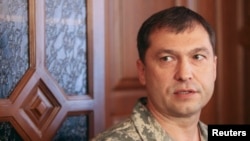KYIV -- Keeping a handle on who's who in the chaotic separatist insurgency gripping Ukraine's frontier with Russia can get a little confusing. Here is a quick guide to the main players in Ukraine's increasingly wild east.
Pavel Gubarev -- the "People's Governor"
The 31-year-old Gubarev was "elected" Donetsk's "people's governor" by his supporters at a pro-Russia rally on Lenin Square in central Donetsk in early March. They then stormed and occupied the regional administration building in Donetsk. Although they were soon evicted, the building changed hands again the following week. Gubarev made calls for a referendum on the Donbas region's status. In contrast to the separatist forces from April onward, the protesters who proclaimed Gubarev "people's governor" were a ragtag bunch in plainclothes and did not openly carry firearms.
On March 6, Gubarev was arrested at his home by the Ukrainian Security Service (SBU) for separatism. During his two-month detention in Kyiv, an officer was filmed at a court hearing demanding he remove his St. George ribbon; Gubarev refused, calling the orange-and-black ribbon "sacred." Gubarev was released in early May in a swap for captured SBU agents. Gubarev's title of people's governor is not an official office of the self-proclaimed "Donetsk People's Republic," which was declared by separatists while he was in jail. On May 23, Gubarev announced the formation of "Novorossia," a political movement aimed at integrating eight eastern and southern Ukrainian oblasts into a new state.
Before dabbling in separatist politics, Gubarev worked as an advertising agent. In one video making the rounds on YouTube, he is dressed as Father Frost, part of a business venture in which the Soviet equivalent of Santa Claus visited children at their homes. He is also alleged to have been a member of the Russian ultranationalist group Russian National Unity in the 1990s.
Vyacheslav Ponomaryov -- the "People's Mayor" of Slovyansk
On April 12, masked gunmen seized security services, police, and government buildings in Slovyansk. Since then, Ponomaryov, 49, has been their public face. Ponomaryov fashions himself as the "people's mayor" of Slovyansk, an industrial town in northern Donetsk Oblast that has become a separatist stronghold and prime target of the Ukrainian government's "antiterrorist operation."
A veteran of the Soviet Navy, he was most recently employed as the boss of a soap-manufacturing factory. Ponomaryov's forces have been accused of a series of kidnappings in Slovyansk. Among those abducted have been American journalist Simon Ostrovsky, Ukrainian journalists, and an OSCE military verification mission invited by the Kyiv authorities. His name was added to the EU blacklist of Russians and Ukrainians with entry bans and asset freezes.
Denis Pushilin -- leader of the self-proclaimed "Donetsk People's Republic" (DNR)
The 33-year-old Pushilin, who was born in nearby Makiyivka and is based in Donetsk, appeared on the scene slightly before Ponomaryov. But he cuts a more dapper and refined figure, sporting a shirt and jacket rather than fatigues and a baseball cap. He became the deputy "people's governor" in early April, effectively replacing Gubarev after the latter was arrested. When the "Donetsk People's Republic" was proclaimed on April 7, Pushilin became one of its leaders. On May 15, he was made chairman of the Supreme Soviet of the self-styled DNR, making him it's effective head of state.
There has been speculation of a rift between separatists in Slovyansk and Donetsk. Pushilin served in the Ukrainian Army at the turn of the millennium. After completing his military service, he worked a series of jobs including casino croupier and pushing financial products for MMM, a successor to the infamous Russian Ponzi scheme that swindled tens of thousands after the collapse of the Soviet Union. He is on the EU's visa blacklist.
Aleksandr Borodai -- The DNR's "Prime Minister"
Borodai, 41, was late to the show, but is rapidly emerging as a key player in the separatist elite.
A Russian citizen, Borodai lived in Moscow prior to the outbreak of unrest in Ukraine. He was made "prime minister" after the DNR adopted a draft constitution on May 15. He joined the ranks of the separatists -- publicly, at least -- only a few weeks ago but has since become one of their more visible figures.
In what may have been a bid to consolidate his power, he recently called for an end to looting by separatists. At his behest, the regional administration building that has served as a headquarters for the Donetsk People's Republic was raided and cleared out by well-organized fighters calling themselves the "Vostok Battalion," a Russian military structure established in the 1990s by a Chechen warlord.
Borodai reportedly defended the Russian White House in 1993 when hard-liners barricaded themselves inside after Boris Yeltsin dissolved the Supreme Soviet. He is also reputed to be close to the Russian nationalist Aleksandr Prokhanov. In the 1990s, Borodai worked as an editor of Prokhanov's ultranationalist newspaper "Zavtra." Borodai is reportedly an old friend of Igor Girkin, the DNR's "defense minister." He told "The New York Times" he had been in Moldova's pro-Moscow breakaway Transdniester region with Girkin in the 1990s "to protect the rights of Russians."
Aleksandr Mozhayev aka "Babai" -- A Bearded Insurgent
Mozhayev, who goes by the moniker "Babai," is a mercurial, bearded Cossack fighter from southern Russia who was -- likely erroneously -- thought to be a GRU military intelligence officer who had served in the South Ossetia 2008 conflict. Pictures likening the two were widely circulated on the web, but the resemblance in fact goes not much further than large beards and military apparel. Mozhayev told "Time" magazine that he was on the run from trumped-up charges of threatening to stab someone in Russia. He was in Crimea prior to the unrest in Ukraine's east.
Igor Girkin aka "Strelkov" – The DNR's "Defense Minister"
Girkin, better known by his pseudonym "Strelkov," is a Russian citizen and, like Borodai, from Moscow. He is in charge of military operations in Slovyansk, where Ponomaryov is the "people's mayor." On May 16, he was made defense minister of the self proclaimed DNR. According to Russian media, he is a colonel and served in conflicts in Transdniester, Bosnia-Herzegovina, and Chechnya. He also wrote for the ultranationalist newspaper "Zavtra." There are 15 articles entered under the name "Igor Strelkov" on "Zavtra's" website.
The SBU has accused him of being an undercover officer with the GRU, the Russian Defense Ministry's Main Intelligence Directorate, and the brains behind the operation in the east. He remained in the shadows of the insurgency until he gave an interview to the Russian daily "Komsomolskaya pravda." Girkin said his paramilitary unit was formed in Crimea and comprised mostly Ukrainians. He is likely one of the most powerful separatist figures in eastern Ukraine.
Much of his past is unclear. However, pictures of Girkin dressed as a gladiator and in other military costumes apparently show that reenacting historical battles is one of his hobbies. Girkin is also on the EU list of those facing asset freezes and entry bans.
Valery Bolotov -- the leader of the "People's Republic of Luhansk"
The 44-year-old Bolotov is the self-styled "people's governor" in Luhansk Oblast. He is the chairman of the Luhansk Oblast's "Paratrooper Veterans Union." Born in the town of Stakhanov in the Luhansk region, Bolotov served in the Soviet Army in the late 1980s and was deployed to Azerbaijan's Nagorno-Karabakh region in 1989-90 when fighting broke out between ethnic Armenians and Azerbaijanis. Days after separatists held an unrecognized independence referendum on May 11, Bolotov reportedly survived an apparent assassination attempt. He is on the European Union's list of figures facing visa ban and asset freezes.
Pavel Gubarev -- the "People's Governor"
The 31-year-old Gubarev was "elected" Donetsk's "people's governor" by his supporters at a pro-Russia rally on Lenin Square in central Donetsk in early March. They then stormed and occupied the regional administration building in Donetsk. Although they were soon evicted, the building changed hands again the following week. Gubarev made calls for a referendum on the Donbas region's status. In contrast to the separatist forces from April onward, the protesters who proclaimed Gubarev "people's governor" were a ragtag bunch in plainclothes and did not openly carry firearms.
On March 6, Gubarev was arrested at his home by the Ukrainian Security Service (SBU) for separatism. During his two-month detention in Kyiv, an officer was filmed at a court hearing demanding he remove his St. George ribbon; Gubarev refused, calling the orange-and-black ribbon "sacred." Gubarev was released in early May in a swap for captured SBU agents. Gubarev's title of people's governor is not an official office of the self-proclaimed "Donetsk People's Republic," which was declared by separatists while he was in jail. On May 23, Gubarev announced the formation of "Novorossia," a political movement aimed at integrating eight eastern and southern Ukrainian oblasts into a new state.
Before dabbling in separatist politics, Gubarev worked as an advertising agent. In one video making the rounds on YouTube, he is dressed as Father Frost, part of a business venture in which the Soviet equivalent of Santa Claus visited children at their homes. He is also alleged to have been a member of the Russian ultranationalist group Russian National Unity in the 1990s.
Vyacheslav Ponomaryov -- the "People's Mayor" of Slovyansk
On April 12, masked gunmen seized security services, police, and government buildings in Slovyansk. Since then, Ponomaryov, 49, has been their public face. Ponomaryov fashions himself as the "people's mayor" of Slovyansk, an industrial town in northern Donetsk Oblast that has become a separatist stronghold and prime target of the Ukrainian government's "antiterrorist operation."
A veteran of the Soviet Navy, he was most recently employed as the boss of a soap-manufacturing factory. Ponomaryov's forces have been accused of a series of kidnappings in Slovyansk. Among those abducted have been American journalist Simon Ostrovsky, Ukrainian journalists, and an OSCE military verification mission invited by the Kyiv authorities. His name was added to the EU blacklist of Russians and Ukrainians with entry bans and asset freezes.
Denis Pushilin -- leader of the self-proclaimed "Donetsk People's Republic" (DNR)
The 33-year-old Pushilin, who was born in nearby Makiyivka and is based in Donetsk, appeared on the scene slightly before Ponomaryov. But he cuts a more dapper and refined figure, sporting a shirt and jacket rather than fatigues and a baseball cap. He became the deputy "people's governor" in early April, effectively replacing Gubarev after the latter was arrested. When the "Donetsk People's Republic" was proclaimed on April 7, Pushilin became one of its leaders. On May 15, he was made chairman of the Supreme Soviet of the self-styled DNR, making him it's effective head of state.
There has been speculation of a rift between separatists in Slovyansk and Donetsk. Pushilin served in the Ukrainian Army at the turn of the millennium. After completing his military service, he worked a series of jobs including casino croupier and pushing financial products for MMM, a successor to the infamous Russian Ponzi scheme that swindled tens of thousands after the collapse of the Soviet Union. He is on the EU's visa blacklist.
Aleksandr Borodai -- The DNR's "Prime Minister"
Borodai, 41, was late to the show, but is rapidly emerging as a key player in the separatist elite.
A Russian citizen, Borodai lived in Moscow prior to the outbreak of unrest in Ukraine. He was made "prime minister" after the DNR adopted a draft constitution on May 15. He joined the ranks of the separatists -- publicly, at least -- only a few weeks ago but has since become one of their more visible figures.
In what may have been a bid to consolidate his power, he recently called for an end to looting by separatists. At his behest, the regional administration building that has served as a headquarters for the Donetsk People's Republic was raided and cleared out by well-organized fighters calling themselves the "Vostok Battalion," a Russian military structure established in the 1990s by a Chechen warlord.
Borodai reportedly defended the Russian White House in 1993 when hard-liners barricaded themselves inside after Boris Yeltsin dissolved the Supreme Soviet. He is also reputed to be close to the Russian nationalist Aleksandr Prokhanov. In the 1990s, Borodai worked as an editor of Prokhanov's ultranationalist newspaper "Zavtra." Borodai is reportedly an old friend of Igor Girkin, the DNR's "defense minister." He told "The New York Times" he had been in Moldova's pro-Moscow breakaway Transdniester region with Girkin in the 1990s "to protect the rights of Russians."
Aleksandr Mozhayev aka "Babai" -- A Bearded Insurgent
Mozhayev, who goes by the moniker "Babai," is a mercurial, bearded Cossack fighter from southern Russia who was -- likely erroneously -- thought to be a GRU military intelligence officer who had served in the South Ossetia 2008 conflict. Pictures likening the two were widely circulated on the web, but the resemblance in fact goes not much further than large beards and military apparel. Mozhayev told "Time" magazine that he was on the run from trumped-up charges of threatening to stab someone in Russia. He was in Crimea prior to the unrest in Ukraine's east.
Igor Girkin aka "Strelkov" – The DNR's "Defense Minister"
Girkin, better known by his pseudonym "Strelkov," is a Russian citizen and, like Borodai, from Moscow. He is in charge of military operations in Slovyansk, where Ponomaryov is the "people's mayor." On May 16, he was made defense minister of the self proclaimed DNR. According to Russian media, he is a colonel and served in conflicts in Transdniester, Bosnia-Herzegovina, and Chechnya. He also wrote for the ultranationalist newspaper "Zavtra." There are 15 articles entered under the name "Igor Strelkov" on "Zavtra's" website.
The SBU has accused him of being an undercover officer with the GRU, the Russian Defense Ministry's Main Intelligence Directorate, and the brains behind the operation in the east. He remained in the shadows of the insurgency until he gave an interview to the Russian daily "Komsomolskaya pravda." Girkin said his paramilitary unit was formed in Crimea and comprised mostly Ukrainians. He is likely one of the most powerful separatist figures in eastern Ukraine.
Much of his past is unclear. However, pictures of Girkin dressed as a gladiator and in other military costumes apparently show that reenacting historical battles is one of his hobbies. Girkin is also on the EU list of those facing asset freezes and entry bans.
Valery Bolotov -- the leader of the "People's Republic of Luhansk"
The 44-year-old Bolotov is the self-styled "people's governor" in Luhansk Oblast. He is the chairman of the Luhansk Oblast's "Paratrooper Veterans Union." Born in the town of Stakhanov in the Luhansk region, Bolotov served in the Soviet Army in the late 1980s and was deployed to Azerbaijan's Nagorno-Karabakh region in 1989-90 when fighting broke out between ethnic Armenians and Azerbaijanis. Days after separatists held an unrecognized independence referendum on May 11, Bolotov reportedly survived an apparent assassination attempt. He is on the European Union's list of figures facing visa ban and asset freezes.














